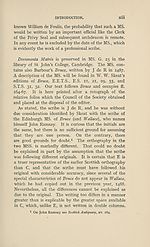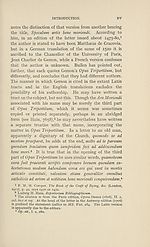Scottish Text Society publications > Third series > Ratis raving and other early Scots poems on morals
(24)
Download files
Complete book:
Individual page:
Thumbnail gallery: Grid view | List view

XIV
INTRODUCTION.
F. W. Miihleisen1 in an elaborate study of portions of the
text and MSS. has set forth differences in both spelling
and writing which render it in the highest improbable
that we have before us the work of one man. Even the
name of the scribe must accordingly be left undetermined.
The Cambridge MS. was written in 1487, and gives accord¬
ingly an extreme lower limit for the date of this poem.
THE CONTENTS.
The description of the contents of Kk. 1. 5, No. 6, follows
for the sake of convenience the order in which the separate
articles appear in the MS. There are added the pages
in which each appears in the present edition. As stated
on p. vii, the whole of No. 6 has been previously printed
(in the MS. order) by Lumby, E.E.T.S. 42.
I, ff. la-4a, The Craft of Deyng = Appendix 1, pp. 166 ff.
It begins at the top of f. 1“ without title and extends
to the bottom of f. 4“. The title is supplied from the
reference in the text, p. 166,1. 5. It is written solid without
break of any kind for sentence or paragraph as it appears
in the print.
The text is a translation, or more accurately a summary,
in English of a portion of a Latin tract, Ars Moriendi,
which was apparently a religious commonplace in the
Middle Ages. This tract occurs in different versions
attributed to different authors, and in the end it was
perhaps a composite document drawing from different
sources. In an introduction to the earliest printed form,
a block-book of c. 1450 reproduced for the Holbein Society
in 1881 (ed. by W. Harry Rylands), Mr George Bullen
1 Textkritische, tnetrische und grammatische Untersuchungen von
Barbour's Bruce. (Bonn, 1913.)
INTRODUCTION.
F. W. Miihleisen1 in an elaborate study of portions of the
text and MSS. has set forth differences in both spelling
and writing which render it in the highest improbable
that we have before us the work of one man. Even the
name of the scribe must accordingly be left undetermined.
The Cambridge MS. was written in 1487, and gives accord¬
ingly an extreme lower limit for the date of this poem.
THE CONTENTS.
The description of the contents of Kk. 1. 5, No. 6, follows
for the sake of convenience the order in which the separate
articles appear in the MS. There are added the pages
in which each appears in the present edition. As stated
on p. vii, the whole of No. 6 has been previously printed
(in the MS. order) by Lumby, E.E.T.S. 42.
I, ff. la-4a, The Craft of Deyng = Appendix 1, pp. 166 ff.
It begins at the top of f. 1“ without title and extends
to the bottom of f. 4“. The title is supplied from the
reference in the text, p. 166,1. 5. It is written solid without
break of any kind for sentence or paragraph as it appears
in the print.
The text is a translation, or more accurately a summary,
in English of a portion of a Latin tract, Ars Moriendi,
which was apparently a religious commonplace in the
Middle Ages. This tract occurs in different versions
attributed to different authors, and in the end it was
perhaps a composite document drawing from different
sources. In an introduction to the earliest printed form,
a block-book of c. 1450 reproduced for the Holbein Society
in 1881 (ed. by W. Harry Rylands), Mr George Bullen
1 Textkritische, tnetrische und grammatische Untersuchungen von
Barbour's Bruce. (Bonn, 1913.)
Set display mode to: Large image | Zoom image | Transcription
Images and transcriptions on this page, including medium image downloads, may be used under the Creative Commons Attribution 4.0 International Licence unless otherwise stated. ![]()
| Publications by Scottish clubs > Scottish Text Society publications > Third series > Ratis raving and other early Scots poems on morals > (24) |
|---|
| Permanent URL | https://digital.nls.uk/106919629 |
|---|
| Description | A collection of over 100 Scottish texts dating from around 1400 to 1700. Most titles are in Scots, and include editions of poetry, drama, and prose by major Scottish writers such as John Barbour, William Dunbar, Gavin Douglas, and George Buchanan. Edited by a key scholarly publisher of Scotland's literary history, and published from the late 19th century onwards by the Scottish Text Society. Available here are STS series 1-3. |
|---|

